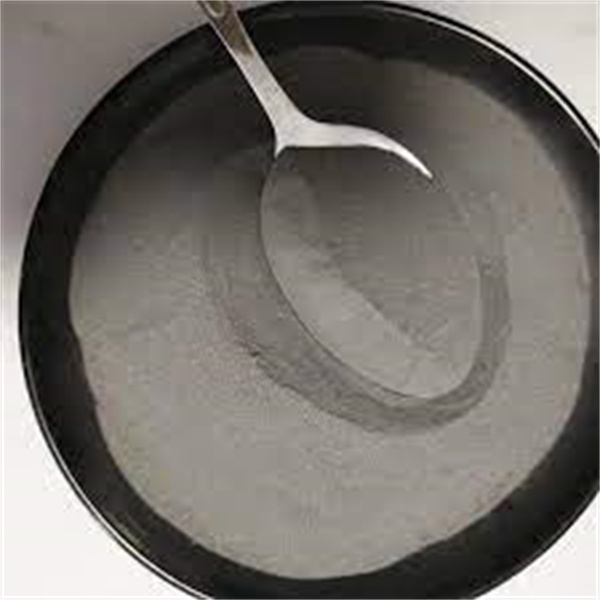Tinjauan Umum tentang Serbuk Logam yang Dikabutkan
industri bubuk logam atomisasi adalah bahan baku penting untuk aplikasi industri seperti pencetakan 3D logam, semprotan termal, cetakan injeksi logam, mematri, dan pengelasan.
Atribut utama dari serbuk logam yang dikabutkan:
| Karakteristik | Deskripsi |
|---|---|
| Metode produksi | Atomisasi gas atau air untuk membuat tetesan halus |
| Bahan | Paduan aluminium, titanium, nikel, nikel, kobalt, baja tahan karat |
| Bentuk partikel | Morfologi bulat atau tidak beraturan |
| Ukuran partikel | Dari 10 mikron hingga 150+ mikron |
| Distribusi ukuran | Kontrol ketat terhadap rentang ukuran partikel |
Kontrol yang tepat atas karakteristik serbuk memungkinkan penyesuaian terhadap persyaratan aplikasi spesifik dari segi komposisi, ukuran, bentuk dan kualitas.
Aplikasi untuk Serbuk Logam yang Dikabutkan
Aplikasi utama untuk serbuk logam yang dikabutkan meliputi:
| Aplikasi | Bahan Khas yang Digunakan |
|---|---|
| Manufaktur aditif | Paduan Ti, Al, Ni, stainless, Co |
| Cetakan injeksi logam | Baja tahan karat, Ti, baja paduan |
| Semprotan termal | Cu, Al, Ni, tahan karat |
| Mematri dan menyolder | Paduan Cu, Ag, Ni |
| Pengelasan | Al, stainless, paduan Ni |
Morfologi bulat dan kontrol ukuran yang ketat yang dapat dicapai dengan atomisasi membuat serbuk ideal untuk proses ini.
Karakteristik khusus seperti kemampuan mengalir, kerapatan semu, dan kemurnian dapat disesuaikan untuk memenuhi persyaratan setiap aplikasi melalui kontrol yang cermat terhadap parameter dan kondisi proses atomisasi.

Metode Memproduksi Serbuk Logam yang Dikabutkan
Metode utama untuk memproduksi serbuk logam yang dikabutkan adalah:
| Metode | Deskripsi |
|---|---|
| Atomisasi gas | Logam yang meleleh dihancurkan oleh semburan gas bertekanan tinggi menjadi tetesan-tetesan halus. |
| Atomisasi air | Aliran logam cair dihancurkan menjadi tetesan oleh air berkecepatan tinggi. |
| Elektroda berputar | Gaya sentrifugal menyebarkan logam cair dari elektroda yang berputar. |
| Atomisasi plasma | Busur plasma melelehkan bahan baku kawat menjadi bubuk yang sangat halus. |
Setiap metode dapat menghasilkan serbuk dengan karakteristik unik yang cocok untuk aplikasi yang berbeda. Atomisasi gas adalah proses yang paling banyak digunakan secara industri.
industri bubuk logam atomisasi Proses Produksi
Proses produksi serbuk logam atomisasi gas yang khas melibatkan:
- Persiapan bahan baku - Peleburan ingot dan paduan
- Atomisasi - Disintegrasi logam menjadi bubuk
- Pengumpulan serbuk - Pemisahan dari gas atomisasi
- Pengayakan - Mengelompokkan bubuk ke dalam pecahan ukuran
- Pengkondisian - Aditif aliran, pengeringan, pencampuran
- Kontrol kualitas - Pengambilan sampel dan pengujian sesuai spesifikasi
- Pengemasan - Tabung, botol, drum untuk pengiriman
Kontrol proses yang cermat pada setiap langkah memastikan kualitas dan karakteristik bubuk yang dapat diulang. Proses ini dilakukan dengan menggunakan peralatan otomatis berskala industri.
Desain dan Pengoperasian Alat Penyemprot Gas
Alat penyemprot gas menggunakan elemen desain utama berikut ini:
| Komponen | Fungsi |
|---|---|
| Bejana tekan | Menahan gas inert pada tekanan tinggi |
| Nozel | Mempercepat gas bertekanan hingga kecepatan supersonik |
| Sistem penuangan leleh | Mengalirkan aliran logam cair ke area atomisasi |
| Siklon dan filter | Pisahkan bubuk dari aliran gas |
| Sistem kontrol | Memantau dan mengatur parameter proses |
Dalam pengoperasiannya, lelehan logam dituangkan ke dalam semburan gas inert berkecepatan tinggi yang menghancurkannya menjadi bubuk halus. Karakteristik serbuk dikontrol oleh parameter seperti tekanan gas, desain nosel, laju tuang, dan panas super lelehan.
Atribut Kualitas Utama dari Serbuk Logam yang Dikabutkan
Atribut kualitas yang penting untuk serbuk yang dikabutkan:
| Atribut | Deskripsi |
|---|---|
| Kisaran ukuran partikel | Distribusi terkendali yang berfokus pada ukuran kritis |
| Morfologi | Bentuk bulat/bulat lebih disukai daripada bentuk yang tidak beraturan |
| Komposisi kimia | Kontrol ketat terhadap elemen paduan dalam setiap batch |
| Kepadatan yang tampak | Kepadatan yang lebih tinggi meningkatkan kinerja produk |
| Kotoran | Meminimalkan pengambilan gas (misalnya oksigen) |
| Karakteristik aliran | Aliran serbuk yang halus tanpa aglomerasi |
Memenuhi spesifikasi aplikasi memerlukan kontrol dan pemantauan kualitas yang ketat pada setiap langkah produksi.
Pertimbangan untuk Penskalaan Proses Atomisasi Gas
Faktor-faktor kunci saat meningkatkan produksi atomisasi gas:
- Batch yang lebih besar meningkatkan kebutuhan inventaris lelehan
- Mempertahankan aliran lelehan yang stabil pada aliran yang lebih tinggi sangat penting
- Peningkatan penggunaan gas harus diakomodasi
- Sistem pengayakan yang lebih besar untuk volume serbuk yang lebih tinggi
- Area penanganan dan penyimpanan material yang diperluas
- Tingkatkan sistem kontrol dan akuisisi data
- Pelatihan personil tentang peralatan yang lebih besar
Manfaat dari produksi skala yang lebih besar termasuk peningkatan produktivitas, fleksibilitas, dan skala ekonomis.
Spesifikasi untuk Serbuk Logam dalam AM
Spesifikasi serbuk yang umum untuk aplikasi manufaktur aditif:
| Parameter | Persyaratan |
|---|---|
| Ukuran partikel | 10-45 mikron umum |
| Morfologi | Permukaan bulat dan halus |
| Komposisi | Kontrol yang ketat terhadap elemen paduan |
| Kepadatan yang tampak | > 4 g/cc yang diinginkan |
| Kemampuan mengalir | Aliran yang sangat baik, tidak ada aglomerasi |
| Kotoran | Oksigen yang diminimalkan lebih disukai |
Memenuhi persyaratan kinerja untuk serbuk AM menuntut komposisi, ukuran, dan kontrol morfologi yang ketat selama atomisasi.
Metode Karakterisasi Serbuk
Metode penting untuk menganalisis serbuk logam yang dikabutkan:
| Metode | Data yang disediakan |
|---|---|
| Pengayakan | Distribusi ukuran partikel |
| Pengukur aliran aula | Laju aliran bubuk |
| Mikroskop optik | Morfologi dan struktur mikro |
| Pencitraan SEM | Morfologi pembesaran tinggi |
| Kepadatan yang tampak | Kepadatan kemasan bubuk |
| Analisis kimia | Komposisi elemen |
Data dari pengujian membantu menghubungkan karakteristik bubuk dengan performa pada aplikasi hilir.
Ukuran Pasar Bubuk Logam Global
Ukuran pasar bubuk logam global:
- Bernilai $2,9 miliar pada tahun 2020
- Diproyeksikan mencapai $5,7 miliar pada tahun 2028
- Pertumbuhan tahunan gabungan sekitar 10%
Pendorong pertumbuhan utama:
| Faktor | Pengaruh terhadap Pertumbuhan |
|---|---|
| Manufaktur aditif | Pertumbuhan permintaan yang cepat untuk serbuk AM logam |
| Tren penurunan berat badan | Peningkatan penggunaan serbuk untuk paduan ringan |
| Suku cadang berkinerja tinggi | Serbuk memungkinkan suku cadang paduan canggih |
| Kendaraan listrik | Serbuk baru yang dikembangkan untuk motor/baterai |
Pasar diproyeksikan akan terus tumbuh dengan kuat karena serbuk memungkinkan teknik manufaktur yang canggih di seluruh industri.
Manfaat Ekonomi dari Produksi Serbuk Logam
Dampak ekonomi dari produksi bubuk logam:
- Menghasilkan material canggih bernilai tinggi dari logam mentah
- Menciptakan pekerjaan manufaktur yang terspesialisasi dan berupah tinggi
- Serbuk logam diekspor secara global dari daerah penghasil
- Mengaktifkan teknologi dan produk manufaktur hilir
- Investasi modal yang signifikan diperlukan untuk fasilitas produksi
- Meningkatnya permintaan meningkatkan aktivitas ekonomi dan investasi
Sektor ini memiliki dampak hulu dan hilir di seluruh rantai pasokan dan manufaktur.
Wilayah Terkemuka untuk Produksi Serbuk Logam
Daerah penghasil bubuk logam utama di seluruh dunia:
| Wilayah | Detail Utama |
|---|---|
| Amerika Utara | Amerika Serikat adalah produsen terbesar di dunia, mengekspor volume yang signifikan ke luar negeri |
| Eropa | Produsen utama di Jerman, Swedia, Inggris yang melayani industri Eropa |
| Asia Pasifik | Cina, India, Korea Selatan adalah produsen utama yang berfokus pada penggunaan domestik |
| Timur Tengah | Pertumbuhan produksi yang didorong oleh industri kedirgantaraan dan minyak/gas |
Kedekatan dengan industri pengguna akhir dan permintaan domestik yang tinggi mendorong pertumbuhan lokal. Ekspor juga melayani wilayah global.
Pendorong Pertumbuhan Industri Serbuk Logam
Pendorong utama yang memacu pertumbuhan industri serbuk logam:
| Pengemudi | Efek Pertumbuhan |
|---|---|
| Manufaktur aditif | Melonjaknya permintaan untuk bubuk logam AM khusus |
| Ringan | Penggantian logam padat dengan serbuk |
| Paduan kekuatan tinggi | Paduan serbuk baru untuk komponen ringan yang kuat |
| Kendaraan listrik | Motor berbasis bubuk, baterai |
| Dirgantara | Suku cadang berbasis bubuk untuk mesin, badan pesawat |
Tren teknologi ini memacu investasi dan perluasan kapasitas produksi serbuk logam.
Tantangan Industri Serbuk Logam
Tantangan utama yang dihadapi industri serbuk logam:
| Tantangan | Efek |
|---|---|
| Biaya modal yang tinggi | Menahan pendatang baru dan investasi baru |
| Harga bahan baku | Volatilitas harga bahan baku berdampak pada biaya |
| Persyaratan kualitas | Biaya pengujian dan pengendalian proses |
| Peraturan keselamatan | Risiko ledakan mendorong biaya kepatuhan |
| Konsolidasi | akuisisi mengurangi persaingan |
Faktor-faktor ini membuat pertumbuhan dan keberlanjutan menjadi tantangan meskipun ada permintaan pasar yang kuat. Perusahaan-perusahaan harus berinovasi agar tetap kompetitif.
Tren Teknologi dalam Produksi Serbuk Logam
Tren teknologi yang sedang berkembang dalam pembuatan serbuk logam:
- Manufaktur aditif komponen peralatan atomisasi untuk fleksibilitas desain
- Atomisasi dengan bantuan ultrasound untuk serbuk yang lebih halus
- Pemodelan tingkat lanjut dinamika fluida dan pembentukan serbuk
- Peningkatan otomatisasi dan pemantauan proses melalui sensor
- Pembelajaran mesin untuk kontrol kualitas prediktif
- Penggunaan kembali bubuk secara langsung dalam pembuatan aditif loop tertutup
- Metode atomisasi gas baru untuk produksi serbuk mikro-nano
- Pengembangan paduan khusus untuk aplikasi yang sedang berkembang
Inovasi teknologi akan memungkinkan kualitas dan konsistensi bubuk yang lebih baik pada volume produksi yang lebih tinggi untuk memenuhi pertumbuhan pasar yang semakin cepat.

Ringkasan Lanskap Industri Serbuk Logam
- Penyedia serbuk penting untuk industri manufaktur besar
- Atomisasi gas adalah teknologi produksi yang dominan
- Permintaan yang berkembang pesat didorong oleh paduan berkinerja tinggi
- Hambatan masuk yang tinggi namun prospek masa depan yang kuat
- Kontrol kualitas dan kemampuan utama pemrosesan yang canggih
- Berkembang bersama manufaktur aditif logam
- Sektor manufaktur berupah tinggi dengan pusat produksi regional
- Siap untuk ekspansi dan pengembangan teknologi yang berkelanjutan
Serbuk logam yang dikabutkan hanya akan meningkatkan kepentingan ekonomi sebagai bahan strategis untuk produksi suku cadang logam tingkat lanjut di seluruh industri penting.
PERTANYAAN YANG SERING DIAJUKAN
| Pertanyaan | Jawaban |
|---|---|
| Apa pasar serbuk logam terbesar di dunia? | Amerika Utara, diikuti oleh wilayah Eropa dan Asia Pasifik. |
| Apa saja aplikasi industri utama untuk serbuk logam? | Manufaktur aditif, semprotan termal, cetakan injeksi logam adalah aplikasi terbesar. |
| Paduan apa yang biasanya dikabutkan menjadi bubuk? | Paduan aluminium, titanium, baja tahan karat, nikel, dan kobalt adalah yang paling umum. |
| Untuk apa atomisasi gas digunakan? | Atomisasi gas adalah metode terdepan untuk produksi komersial serbuk logam. |
| Bagaimana serbuk logam dipisahkan berdasarkan ukurannya? | Penyaringan/penapisan digunakan untuk mengklasifikasikan serbuk ke dalam rentang ukuran partikel tertentu. |
